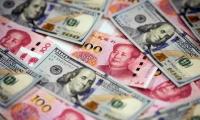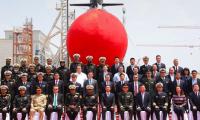ISLAMABAD: The negotiations with China on increasing the coverage of up to 97 per cent of items in prevalent FTA-II will begin once the newly elected government formally takes over the charge, as Pakistan under (Free Trade Agreement) FTA-II is still facing a trade deficit of $20 billion in trade with a tested friendly country.
“Pakistan wants more products coverage in its favour under FTA-II and treatment as is being extended by China to ASEAN countries,” a senior official of the commerce ministry told The News. “However, the Chinese authorities also want in return more coverage of their items in FTA-II in Beijing’s favour but Pakistan wants unilateral coverage of more products, not bilateral.”
The caretaker minister, he said, during his visits to China agitated about this issue, but the Chinese authorities promised to consider Pakistan’s request after the instalment of newly elected government.
China is Pakistan’s largest trading partner and biggest source of foreign direct investment. In 2022, Pakistan’s exports to China were recorded at $2.53 billion while China’s exports to Pakistan stood at $23.09 billion, according to the United Nations COMTRADE database. “The initial FTA was signed on 24 November 2006 and concluded in December 2012. The second phase was signed on 28 April 2019 and came into force on 1 January 2020. Phase two will conclude in 2024. Under FTA-11, the products’ coverage from both sides is 75 per cent, but now Pakistan wants to increase it to 97 per cent unilaterally, not bilaterally, to ensure the balance in trade acceptable to it. After the China-Pakistan FTA-1 came into force, trade between China and Pakistan grew by 242pc.” In 2013, bilateral trade between China and Pakistan was above US$9 billion, increasing from their bilateral trade in 2006 of US$3.5 billion. Pakistan’s exports to China in 2016 were US$1.6 billion, growing from that in 2006 of US$0.5 billion. Similarly, China’s exports to Pakistan also increased, from US$1.4 billion in 2006 to US$12.1 billion in 2016. Following the implementation of the CPFTA, China became the primary supplier for Pakistan in several goods such as organic chemicals, fertilizers, electronic equipment, staple fibres and footwear. Pakistan became a major supplier to China for gums, resins and cotton. Tariff concessions under the CPFTA had also allowed Pakistan to import cheap raw materials and machinery from China, which is utilised for manufacturing Pakistani products.
By the end of the initial phase, China and Pakistan had abolished tariffs on 35.5pc of product lines. Owing to more exports from China than from Pakistan, the trade deficit between the nations increased from US$1.4 billion to US$12.1 billion. By 2018 their trade deficit was 35pc.
The CPFTA-1 also received criticism from the domestic industry in Pakistan and Pakistani business groups. Domestic producers in Pakistan were concerned over the increased inexpensive Chinese exports infiltrating the Pakistani domestic market, of which the outcome was increased competition for domestic production in Pakistan. Business groups in Pakistan communicated concern about Pakistan not being granted adequate market access for their main exports, such as rice, frozen fish, knitwear, cotton apparel and leather hides. They described how Pakistan was utilising only 5pc of the tariff concessions available to them, whereas China was using 57pc of their available tariff concessions. Business groups conveyed further criticism about China granting greater tariff concessions to other countries and regions, for example, ASEAN countries within the ASEAN-China Free Area, than it did for Pakistan in the CPFTA. The repercussion of this is that it reduces Pakistan’s comparative advantage in its main exports and product specialties.
Phase two of the CPFTA enhances market access for both countries. In the second phase, China has reduced tariffs on 44pc more product lines than was previously reduced in phase one. China immediately eliminated tariffs on 313 product lines that Pakistan is a major exporter of, primarily goods such as textiles, frozen meat and other animal products, seafood, prepared food, chemicals, plastics, oilseeds, footwear, engineering goods, machinery, leather and auto parts.
Pakistan has offered immediate market access to China on products including raw materials, intermediate goods, and machinery. China and Pakistan will reduce tariffs on 412 product lines to 20pc within five years. Both nations will also gradually establish 75pc of product lines as duty-free, and 93pc of product lines will have tariffs reduced to less than 10pc in 10 years by China and 15 years by Pakistan. However, after CPFTA-11, Pakistan is still facing a huge deficit in the trade balance which is why Pakistan wants more products coverage taking it up to 97pc in its favour.
KP CM Gandapur accused federal government of adopting an unfair attitude towards KP and vowed not to compromise on...
Blinken raised the matter during five-and-a-half hours of talks with China’s top diplomat Wang Yi in Beijing
The chief minister directed the sports minister to review the prospects of cooperation with the delegation
According to Geo News, the Sunni Ittehad Council is second in the National Assembly and PPP occupies the third place
PM has directed Secretary Cabinet Division to take necessary foolproof measures to prevent leakage of agenda and...
The meeting concluded with the agreement on the next steps for commencement of the process of digitalisation of...







